Cleaning up fish farms
Although fish farms can supply lots of food, these operations may also cause pollution and hurt wild populations.
If you were to drive or fly coast to coast across the United States, you’d encounter an incredible variety of farms along the way.
There are cranberry bogs, pecan orchards, cornfields, llama farms, peppermint fields, cattle ranches, rice paddies, and more. Along just one short stretch of road in California, farmers grow strawberries, lettuce, artichokes, and Brussels sprouts.
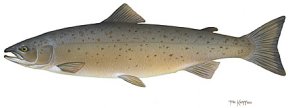 |
|
Atlantic salmon are raised on fish farms off the coasts of British Columbia, Washington State, New Brunswick, Norway, Scotland, Chile, and elsewhere around the world.
|
| Timothy Knepp, U.S. Fish and Wildlife Service |
Even venturing beyond the coast, you’d find farms in the water, producing fish, shellfish, and even seaweed. It’s called aquaculture.
About one-third of the fish that people eat already comes from such farms. The United Nations estimates that, in 25 years, aquaculture will produce more than half of our seafood.
“There’s simply not enough wild fish to supply the growing demand for seafood,” says Jennifer Dianto. She’s an environmental scientist with the Monterey Bay Aquarium in California.
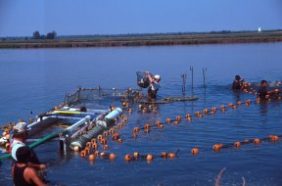 |
|
This farm near Belzoni, Mississippi, produces catfish.
|
| David Heikes, Agricultural Research Service, U.S. Department of Agriculture |
Although fish farms could supply lots of food and save wild populations from dying out, there are serious concerns about these farms.
For example, fish could escape, says Paul Sandifer. He’s a scientist with the National Oceanic and Atmospheric Administration. Because the escapees often don’t normally live in the surrounding waters, they could have a bad effect on wild fish in the area.
Moreover, fish in a confined space produce a lot of waste, which can pollute nearby waters. Diseases can spread like wildfire within a farm and infect fish swimming nearby.
Despite such concerns, the U.S. Commission on Ocean Policy recently proposed that increased aquaculture would be a good thing—if it were managed properly. New technology can help solve the problems, says Sandifer, who was a commission member.
Friendly farms
Scientists are already testing new techniques for setting up environmentally friendly fish farms.
In the Caribbean, fish farmers are raising cobia in huge underwater cages. Cobia are long, slim fish that grow as heavy as 30 pounds. They prefer warm water and can often be found seeking shelter in harbors and near wrecks and reefs in the Florida Keys and elsewhere around the world.
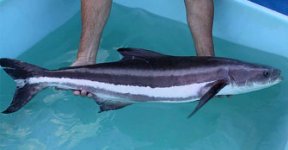 |
|
Now farmed, cobia prefer to live in warm water in the Caribbean and elsewhere around the world.
|
| National Oceanic and Atmospheric Administration |
The idea is to have the cages offshore in deep waters where there are strong currents, says Daniel Benetti. He’s a scientist at the University of Miami.
He and his colleagues sank cages 90 feet below the surface, where more than 500 million gallons of water flows through a cage per day. These currents flush away the waste and leftover fish food that would otherwise collect beneath the cages.
When scientists tested the water near these farms, they found that the nearby water wasn’t significantly dirtier than water farther away, Benetti says.
In the much colder waters off eastern Canada, Thierry Chopin of the University of New Brunswick and his coworkers have experimented with combining salmon farming with other types of aquaculture.
“Don’t put all your salmon eggs in the same basket,” Chopin says. The waste from one species can be food for another.
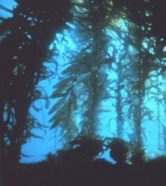 |
|
Kelp thrives near salmon farms.
|
| National Oceanic and Atmospheric Administration |
The researchers have combined salmon farming with mussel and kelp farming. They found that mussels grew better right next to the fish cages, and kelp thrived when it grew a bit farther away.
At the same time, the shellfish and seaweed helped clean up waste generated by the salmon farms, Chopin says.
Attack of the sea lice
Still, many marine scientists are concerned about fish farms, especially salmon operations.
In 2002, the number of wild salmon along Canada’s west coast suddenly dropped sharply. Because there are a large number of fish farms along the coast, scientists looked for a connection between the farms and the population collapse.
They identified one possible culprit: sea lice. Sea lice are tiny parasites that thrive on farms, which often have a million salmon in one place.
 |
|
Sea lice (dark shapes) cling to young wild pink salmon that have swum past a fish farm in British Columbia.
|
| A. Morton, University of Alberta |
“That represents a huge buffet to something like the sea lice,” says John Volpe. He’s a marine ecologist with the University of Victoria in British Columbia.
Whereas adult salmon can tolerate lice, young salmon, which weigh less than an ounce, are vulnerable. For such a small fish, having a sea louse attach itself is like having a 50-pound blood-sucking tick latch on to a 150-pound person, Volpe says. Imagine carrying that around!
The researchers looked for lice infestations as young wild salmon migrated down a narrow channel, past a salmon farm, and out into the ocean. The infection rates were 73 times higher than normal when the young fish passed the farm, Volpe says.
When they pass by farms, baby fish pick up sea lice hitchhikers. And, if the fish survive, the lice they carry reproduce and infect even more fish as the schools migrate to the ocean. In the end, fewer fish make it to the ocean, and wild salmon populations drop.
The same problem could occur near salmon farms in Scotland, Ireland, Norway, and elsewhere.
Choosing seafood
If some fish farms appear to be hurting the environment and others seem to be okay, how does a hungry, but environmentally aware kid know which kind of seafood to eat?
That’s where publications such as the Monterey Bay Aquarium’s Seafood Watch guide come in handy. The guide lists fish in three, color-coded categories: best choices (green), good alternatives (yellow), and avoid (red). It covers both wild-caught and farmed fish.
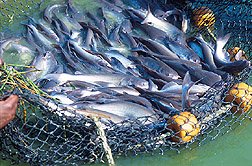 |
|
These catfish come from a farm.
|
| Peggy Greb, Agricultural Research Service, U.S. Department of Agriculture |
For farmed fish, scientists look at how many wild fish it takes to make the fish meal and fish oil that feeds farmed fish. They look at the effect of fish farm escapees and whether the farms spread diseases or parasites. They look at what happens with fish waste and how the farms are managed.
“No one wants to be on the red list,” says Dianto, who’s the Seafood Watch program manager. And people seem to be paying attention. The Seafood Watch program has already distributed 5 million guides.
So, if you love catfish, tilapia, or mussels, there’s no problem. They’re all on the green list, which means they’re raised in a sustainable manner. Salmon lovers have to be more careful. Whereas wild-caught Alaskan salmon are in the green, salmon farms have a long way to go before their products would make the list.
Going Deeper:







